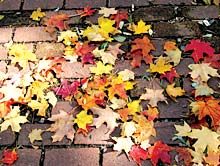All summer, the five huge old maples around my home create a cool, refreshing microclimate—inside and out. Beyond this shady haven looms the baking heat. One of these maples holds my daughter’s favorite childhood entertainment, a simple swing built by her dad. Trees like this beg to be climbed, to harbor forts, to serve as third base, to shelter evening picnics lit by fireflies.

But it doesn’t end with your friends and family: Think of all the critters who will utilize your tree. At our house, bees sipping maple nectar buzz that spring is finally here. Birds burst into song, nest and feed their young. Mr. Knock-It, the pileated woodpecker, routinely drops by. Numerous insects and small animals also call our maples home. We’ve even seen black snakes entwined in them (but don’t let that intimidate you).
The bright-green leaves of the silver maple (Acer saccharinum) show their silvery underbellies when the wind blows. This wonderful shade tree with yellow fall color has brittle wood that breaks easily in storms, and roots that heave sidewalks. Silver maples would not be my first choice, but before discounting them entirely, consider that they’re also your quickest ticket to shade, are highly adaptable, and will happily grow just about anywhere.
‘Autumn Blaze’ (Acer x freemanii) is a cross between a silver maple and a red maple. It grows faster than a red maple but isn’t as breakable as a silver maple. One of the first maples to color up in the fall, it turns a gorgeous deep red. The thrill dissipates as it fades to a brownish-red, but this doesn’t diminish its popularity at garden centers.
Red maples are relatively fast-growing, with predominantly red fall color. Among the many lovely cultivars, my favorites are ‘October Glory’ and ‘Red Sunset’, even though they color up later. Both have a lovely vivid crimson color, with a yellowish background that never takes on the brown tone of ‘Autumn Blaze’. Soil of any pH is suitable for red maples, but fall color may be better when they’re grown in acid soils. The versatile red maple (Acer rubrum) has few pest or disease problems, can tolerate an urban environment, and makes an excellent street tree.
Many people consider the sugar maple (Acer saccharum) the maple of choice. The fall color of this stately tree is somewhat unpredictable, ranging from yellow to orange to red, but it’s always breathtaking. Catch it in its fall glory at the nursery and you’ll have a better idea what color a particular tree might display come fall. Maple syrup, furniture and flooring are all produced from this tree. Sugar maples tolerate fairly diverse conditions, but they’re not your best choice for polluted urban settings or brutal locations.
When selecting a maple, check the labeling concerning the tree’s height, width and general shape. Each one is a little different. These are all native species and therefore more generally adaptable than trees from far-flung regions, but that doesn’t mean you can plant them and then ignore them.
Be sweet to your tree and it will live up to your dreams. Dig a hole two to three times the width of the pot and no deeper. Amend your soil with Nature’s Helper plus a handful of phosphate, mixing everything together well. Always incorporate 50 percent native soil with your amendments, so the plant roots will have an affinity for it. Loosen the roots, plant and water deeply, adjusting the plant if it sinks deeper than the surrounding soil. Water your tree once a week—deeply, to the bottom of the roots—for the entire first year, and more often during the first few weeks.
A maple is a thing of substance that anchors your home landscaping. Just sit back and enjoy the yearly cycle; bare limbs to delicious green shade to magnificent fall color. Delight in the constant parade of wildlife your tree attracts. Watch your kids climb and swing and play hide-and-seek. And rest easy, knowing that your tree is helping moderate climate change on our dear and only planet.
[Ruth Uffelman works at a local garden center.]


Before you comment
The comments section is here to provide a platform for civil dialogue on the issues we face together as a local community. Xpress is committed to offering this platform for all voices, but when the tone of the discussion gets nasty or strays off topic, we believe many people choose not to participate. Xpress editors are determined to moderate comments to ensure a constructive interchange is maintained. All comments judged not to be in keeping with the spirit of civil discourse will be removed and repeat violators will be banned. See here for our terms of service. Thank you for being part of this effort to promote respectful discussion.